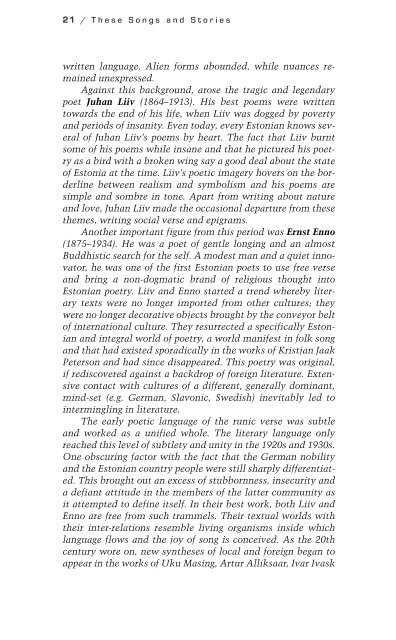*tuule makett - Infopoint Estonian Culture
*tuule makett - Infopoint Estonian Culture
*tuule makett - Infopoint Estonian Culture
Create successful ePaper yourself
Turn your PDF publications into a flip-book with our unique Google optimized e-Paper software.
2 1 / These Songs and Stories<br />
written language. Alien forms abounded, while nuances remained<br />
unexpressed.<br />
Against this background, arose the tragic and legendary<br />
poet Juhan Liiv (1864–1913). His best poems were written<br />
towards the end of his life, when Liiv was dogged by poverty<br />
and periods of insanity. Even today, every <strong>Estonian</strong> knows several<br />
of Juhan Liiv’s poems by heart. The fact that Liiv burnt<br />
some of his poems while insane and that he pictured his poetry<br />
as a bird with a broken wing say a good deal about the state<br />
of Estonia at the time. Liiv’s poetic imagery hovers on the borderline<br />
between realism and symbolism and his poems are<br />
simple and sombre in tone. Apart from writing about nature<br />
and love, Juhan Liiv made the occasional departure from these<br />
themes, writing social verse and epigrams.<br />
Another important figure from this period was Ernst Enno<br />
(1875–1934). He was a poet of gentle longing and an almost<br />
Buddhistic search for the self. A modest man and a quiet innovator,<br />
he was one of the first <strong>Estonian</strong> poets to use free verse<br />
and bring a non-dogmatic brand of religious thought into<br />
<strong>Estonian</strong> poetry. Liiv and Enno started a trend whereby literary<br />
texts were no longer imported from other cultures; they<br />
were no longer decorative objects brought by the conveyor belt<br />
of international culture. They resurrected a specifically <strong>Estonian</strong><br />
and integral world of poetry, a world manifest in folk song<br />
and that had existed sporadically in the works of Kristjan Jaak<br />
Peterson and had since disappeared. This poetry was original,<br />
if rediscovered against a backdrop of foreign literature. Extensive<br />
contact with cultures of a different, generally dominant,<br />
mind-set (e.g. German, Slavonic, Swedish) inevitably led to<br />
intermingling in literature.<br />
The early poetic language of the runic verse was subtle<br />
and worked as a unified whole. The literary language only<br />
reached this level of subtlety and unity in the 1920s and 1930s.<br />
One obscuring factor with the fact that the German nobility<br />
and the <strong>Estonian</strong> country people were still sharply differentiated.<br />
This brought out an excess of stubbornness, insecurity and<br />
a defiant attitude in the members of the latter community as<br />
it attempted to define itself. In their best work, both Liiv and<br />
Enno are free from such trammels. Their textual worlds with<br />
their inter-relations resemble living organisms inside which<br />
language flows and the joy of song is conceived. As the 20th<br />
century wore on, new syntheses of local and foreign began to<br />
appear in the works of Uku Masing, Artur Alliksaar, Ivar Ivask


